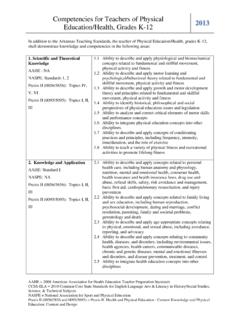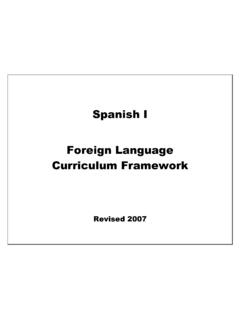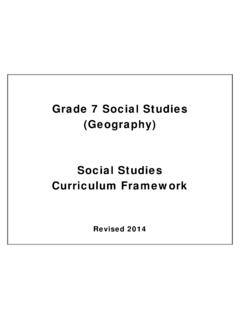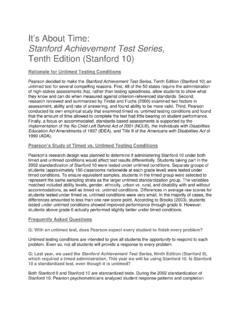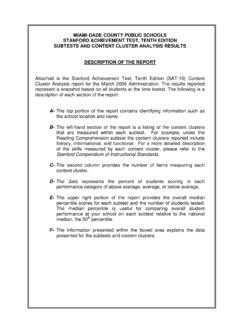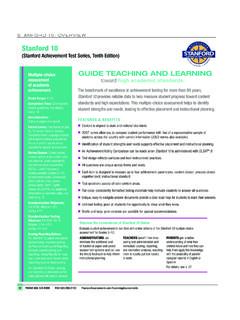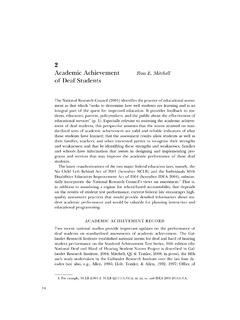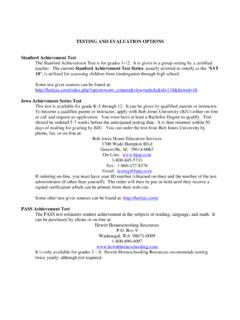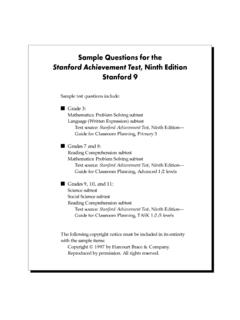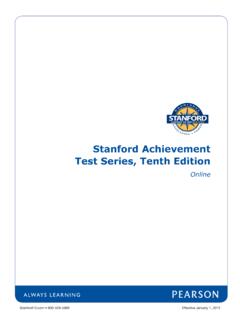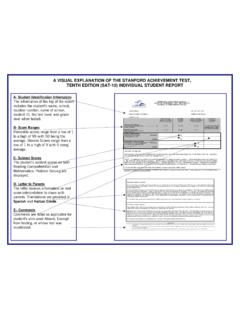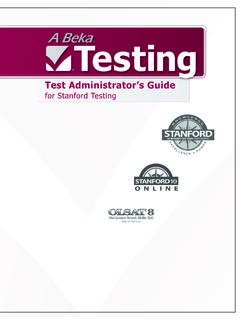Transcription of Test Administration Manual - State Board of Education
1 Test Administration ManualStanford achievement Test series , Tenth EditionAPRIL 2010 GRADE9 Important DatesApril 5 16, 2010 stanford achievement Test series , Tenth Editionadministration dates and make-up Administration datesSECURITY WARNINGAll test items used in the Arkansas Comprehensive Testing, Assessment, and Accountability Program are CONFIDENTIAL and must be kept secure at all times. NO PART of this test may be reviewed, duplicated, or reproduced by ANY means. All test booklets and used answer documents must be returned as use, review, duplication, or reproduction of ANY or ALL portions of the test booklets and answer documents is Department of EducationCopyright 2010 by the Arkansas Department of Education . Copyright 2010 NCS Pearson, Inc. All rights reserved. No part of this publication may be reproduced or transmitted in any form or by any means, electronic or mechanical, including photocopy, recording, or any information storage and retrieval system, without permission in writing from the copyright owner.
2 Pearson is a trademark, in the and/or other countries, of Pearson Education , Inc. or its affiliate(s). The ACTAAP logo is a trademark of the Arkansas Department of Education . Portions of this work were previously published. Printed in the United States of for Test Administrator s NotesName: District: School: Table of ContentsSpace for Test Administrator s Notes 2 Letter to Teachers 5 Introduction 6 stanford 10 6 Special Features 7 What stanford 10 Assesses 7 Mathematics 8 Writing 8 Reading 9 General Directions for Administering 10 Preliminary Planning 10 Test Administration Scheduling 10 Materials Required by the Examiner 10 Materials Required by Each Student 11 Proposed Schedule for Administering 11 Test Security Procedures 11 Advance Announcements 12 Calculator Use and Restrictions 12 Mathematics Reference Sheets 13 Students to be Tested 14 Students to be Tested 14 Disabled Students ( 94-142) 14 Limited English Profi cient (LEP)
3 Students 15 First-Year Limited English Profi cient (LEP) Students 15 Monitored Former Limited English Profi cient (LEP) Students 15 Transfer Students 16 Migrant Students 16 Highly Mobile Students 16 Alternative Learning Environment Students 16 Student Test Materials 17 Requirements for Student Test Materials 17 Student Pre-Identifi cation (Pre-ID) Labels 17 Large-Print Test Booklets 18 Braille Test Booklets 19 Procedures Prior to Test Administration 20 Testing Environment 20 Ten-Digit State Reporting ID/Social Security Number 20 Materials Needed for Test Administration 20 Final Preparations for Test Administration 21 Procedures During Test Administration 22 Testing Session Information 22 Monitoring Students During Testing Sessions 22 Interruption of Testing Sessions 22 Damaged or Soiled Documents 22 Distribution of Materials 22 Gridding the Demographic Page 22 Checklist for Test Administrators 23 Before Testing 23 Final Preparations for Testing 23 During Testing 23 Following Testing 24 Specifi c Directions for Administering 25 Student Demographic Information 26 Directions for Coding Answer Documents 26 Completing the For Teacher Use Only Box 27 Reason Not
4 Tested 33 Student Demographic Information Test Administration Script 34 Mathematics 35 Writing 38 Reading Comprehension 40 Procedures Following Test Administration 42 General Procedures for Returning Test Materials 42 Requirements for Coding the For Teacher Use Only Box 42 Returning Test Materials to the School Test Coordinator 43 Separate and Label Materials 43 Organize Test Materials 44 Appendix A 45 Arkansas Department of Education Test Security Guidelines 45 Security Procedures 47 School Security Checklists 47 Test Security Affi davits 48 Appendix B 49 Accommodations for Testing 49 Appendix C 51 Reading and/or Transcription of the Examinations 51 Appendix D 52 Sample Student Pre-Identifi cation Label 52 Appendix E 53 Sample Affi davit Waiver Form for Providing an Approved Accommodation 53 Appendix F 54 Sample Header Sheet 545 LETTER TO TEACHERSDear Teacher:It is with great pride that we present the Tenth Edition of the stanford achievement Test series ( stanford 10).
5 The stanford series has long been considered the nation s premier achievement we began the development of stanford 10, we traveled around the country and listened to many groups of teachers, curriculum directors, and school administrators talk about what is good and what is bad in achievement testing. We asked about test content, testing time, item types, page layout and format, information systems, and ancillary materials. Then, in our planning, we made every effort to incorporate more of what teachers like and eliminate things that have been problematic. Therefore, we believe that this new edition is more responsive to teachers and students assessment needs. The new stanford offers something for everybody, whether your needs are for a full-length test with individual student objectives information or an abbreviated test that can be administered quickly to get a snapshot of group trends.
6 stanford can offer it to you with maximum reliability and are eager to know what you think of the stanford 10 series . Please take the time to write to us and let us know your opinions. Your input will help us to continue to improve our materials and make them more valuable for ,Pearson6 The stanford achievement Test series , with a rich history dating from the early twentieth century, measures students school achievement . This Tenth Edition of the stanford battery ( stanford 10) provides updated content that reflects the national and State standards, curriculum, and educational trends of the beginning of the twenty-first stanford achievement Test first appeared in 1923. Revisions were published in 1929, 1940, 1953, 1964, 1973, 1982, 1989, and 1996. Each revision was provided in order to (1) update content in order to better align the test with the current curriculum trends; (2) update the normative information in order to make comparisons more valid; (3) increase and improve the kinds of information available from testing; and (4) revise the look of the test to make it more engaging and relevant to stanford series comprises thirteen battery levels that assess students from kindergarten through grade 12.
7 The stanford Early School achievement Test (SESAT) consists of two levels that measure achievement of children in kindergarten and the first half of first grade. The eight levels of the stanford achievement Test measure the important learning outcomes of the curriculum from the second half of grade 1 through the end of junior high school. The three levels of the stanford Test of Academic Skills (TASK) are intended for use as measures of those skills in grades 9 through 12 that are requisite to continued academic training. At all levels of stanford achievement Test and stanford Test of Academic Skills, there are two parallel forms that are equivalent in both content and 10In order to provide maximum assessment opportunities of all kinds for all schools, stanford 10 has moved beyond the ordinary boundaries of norm-referenced achievement FeaturesStanford 10 has many other special features that make it stand out from other achievement batteries.
8 Full-color, student-friendly layout Innovative new types of multiple-choice questions Items that call for actual performance on the part of the students encourage divergent thinking and problem on Thinking Skills All of the items in stanford 10 assess either Basic Understanding or Thinking Skills, with more items than ever before assessing the higher-order with the National Assessment of Educational Progress (NAEP) The stanford 10 Reading Comprehension subtest provides similar information about students reading ability to that from the NAEP. Scores include type of reading selection literary, informational, and functional as well as the important reading processes Initial Understanding, Interpretation, and Critical Analysis and selections commissioned from published authors Many of the selections in the Reading Comprehension subtest of stanford 10 are written by well-known authors of children s and young people s books and subtest stanford 10 has a Mathematics Problem Solving subtest that reflects the National Council of Teachers of Mathematics (NCTM)
9 Principles and Standards for School on the NCTM Principles and StandardsAs specified by the NCTM Principles and Standards, most mathematics items in stanford 10 are presented in context and emphasize the problem solving and reasoning skills promoted by the NCTM Principles and Standards and all State content and Process Cluster Scores In addition to Thinking Skills scores, stanford 10 includes embedded process scores. These scores require no additional testing stanford 10 AssessesStanford 10 assesses the basic curricular objectives. At the elementary, middle, and junior high school levels, the concepts and skills assessed are those ordinarily taught during the second half of any given year and the first half of the following year. This midyear-to-midyear configuration provides for a more focused assessment of students tested in the spring of one grade and the fall of the next than could a single test level intended for use in both the fall and spring of the same school year.
10 At the high school levels, where the TASK levels assess basic skills, a given level is appropriate for use in both the fall and spring of the same school stanford 10 mathematics subtest assesses the entire breadth of mathematical content recommended by the National Council of Teachers of Mathematics (NCTM), including number and operations, algebra, geometry, measurement, data analysis, and probability. At the SESAT 1 and SESAT 2 levels and the TASK levels, mathematics is assessed in a single subtest. In its Principles and Standards for School Mathematics, NCTM recognizes the necessity for developing computational fluency in students through mathematics Education . Developing fluency requires a balance and connection between conceptual understanding and computational fluency. Several features characteristic of the stanford 10 support vital goals for school mathematics.


